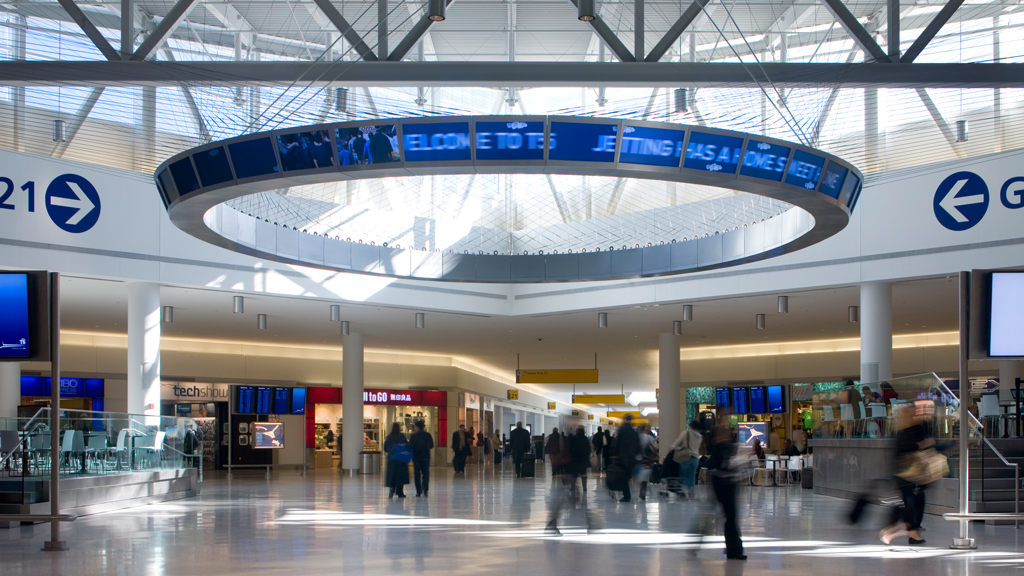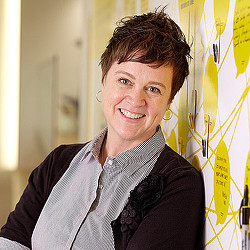It’s Time to Rethink Signage and Wayfinding for Transportation Hubs
May 11, 2020 | By Beth Ready and Ty Osbaugh
Editor’s Note: This post is part of our ongoing exploration of how design is responding to the COVID-19 pandemic.
A close alliance between environmental graphic design and airport architecture may seem unlikely at first, but these fields are remarkably interdependent. This post brings the two together to explore how to stay safe when the world starts traveling again.
Fast forward to when you’re ready to take your next flight. Maybe that’s six months from now. Maybe longer. Maybe, depending on your job, family situation, or other circumstances out of your control, your next flight is already on the horizon. When that day comes, what’s it going to take to make you feel safe?
Transportation hubs — especially airports — were anxiety triggers long before we had to deal with a global pandemic. To dispel that unease, designers have successfully deployed signage and wayfinding strategies to guide travelers through unfamiliar environments while communicating across languages and cultures.
The best signage and wayfinding strategies are often unseen, conveying the bare minimum amount of information to get you from point A to point B. If, at the end of the trip, you didn’t remember a single thing about the signs that brought you home, that was a good thing.
In the short term, this will change. A more “in your face” strategy is needed for COVID-19 and the need to distance ourselves from other travelers. The stakes are too high to risk someone missing the message.
Phase 1: Manage the queueA primary hot button issue now, and for the immediate future, is queuing. We are seeing ad hoc solutions pop up all over the place, with the most popular strategy of putting stickers or tape on the floor at six-foot intervals in queuing areas. These floor graphics could become much more sophisticated and effective.
We’re thinking about air travel in particular here, but the strategy is relevant wherever queuing happens. Subway stations, bus stops, clothing retailers, and restaurant chains are likely to implement similar measures.
Airports happen to have a high number of places where pedestrian traffic clogs up. Imagine the journey from curbside drop off to the TSA line to baggage claim — graphic cues and explicit signage will be especially important in shaping behavior as travelers move through that journey.
Beyond social distancing, we may want to remind passengers to wash their hands or cough into their elbows with strategically placed signage.
Temporary sticker solutions could also be placed on doors or anywhere we interact with the physical environment. We can do it elegantly and in a manner that grabs your attention, striking a balance that gets at the heart of graphic design’s social purpose.
Phase 2: Invest in digital wayfindingIn the long term, there will be a more fundamental change. Over the past 20 years, we’ve learned to take trends with a grain of salt. But the move towards digital signage and wayfinding design is much more than a trend. This moment is a tipping point for design. The future will be digital, and it will be flexible.
While analog signage strategies work well in normal times, they leave much to be desired in a crisis. They are too static. Transit hubs must now accept the fact that they might need to change their messages and norms on a dime.
Here’s how it can play out:
- Phase one: Solve for queuing. A ceiling-integrated lighting system could delineate points on the floor for travelers to line up. Such a system could integrate biometric sensors. This is far more elegant and eye-catching than pasting down stickers, and digital solutions would have the added benefit of being adaptable to new circumstances.
- Phase two: If social distancing guidelines relax, the lights could simply be turned off, or adjusted to create a new queuing system that doesn’t rely on cumbersome stanchions.
- Phase three: To take it further, if we extend our thinking about what could be digital, even gate numbers could change to prevent crowding and overflow in hold rooms. This would give airports flexibility that would have been unimaginable in the past.
We’ve been moving towards this flexibility for some time. Years ago, we implemented a signage and wayfinding system for Cleveland Hopkins International Airport. There, the design uses a system of panels that nest seamlessly in each sign — using an industrial-strength hook-and-loop material to make them easily changeable. In the near future, the airport could swap in a premade message, symbol, or arrow panel to an existing sign rather than order an entirely new sign. This was an important evolution in our thinking that also happened to be a cost-saving measure. New digital technologies push this flexibility even further.
The potential upside for digital signage and wayfinding is boundless. A digital strategy can bring clarity to the passenger experience, which will have to integrate a series of new behaviors. Top of mind for any traveler getting off a plane or subway will be where to find the nearest hand-washing or sanitizing station, a new first step that will require clear guidance.
The same concern could also impact our new shopping experiences – both inside and outside transportation hubs. With grocery stores and other retailers implementing temporarily lowered maximum capacities, digital displays and sensors could let people know how full a store is before they enter, and what their estimated wait time might be.
Technology also opens the door for a new level of emotional resonance. We won’t be shaking hands for a while, but personalized messaging that lets us know we are welcome and safe can bring some humanity back to the travel experience.
In such uncertain times, there is solace to be found in consistency. The principles for successful signage and wayfinding projects are largely the same across airports, workplaces, hospitals, universities, and even cities.
We started by asking what it would take for you to feel safe enough to fly again, but in reality, that’s a question we’ll face for every single activity we resume.
For media inquiries, email .


